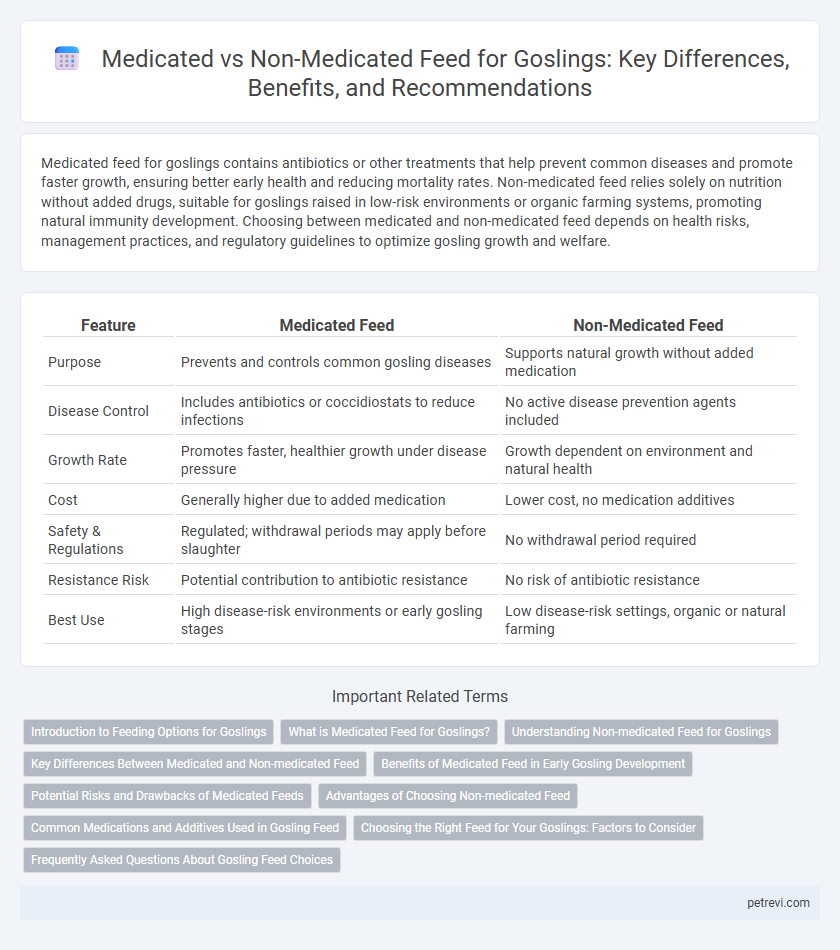Medicated feed for goslings contains antibiotics or other treatments that help prevent common diseases and promote faster growth, ensuring better early health and reducing mortality rates. Non-medicated feed relies solely on nutrition without added drugs, suitable for goslings raised in low-risk environments or organic farming systems, promoting natural immunity development. Choosing between medicated and non-medicated feed depends on health risks, management practices, and regulatory guidelines to optimize gosling growth and welfare.
Table of Comparison
| Feature | Medicated Feed | Non-Medicated Feed |
|---|---|---|
| Purpose | Prevents and controls common gosling diseases | Supports natural growth without added medication |
| Disease Control | Includes antibiotics or coccidiostats to reduce infections | No active disease prevention agents included |
| Growth Rate | Promotes faster, healthier growth under disease pressure | Growth dependent on environment and natural health |
| Cost | Generally higher due to added medication | Lower cost, no medication additives |
| Safety & Regulations | Regulated; withdrawal periods may apply before slaughter | No withdrawal period required |
| Resistance Risk | Potential contribution to antibiotic resistance | No risk of antibiotic resistance |
| Best Use | High disease-risk environments or early gosling stages | Low disease-risk settings, organic or natural farming |
Introduction to Feeding Options for Goslings
Medicated feed for goslings contains specific additives designed to prevent or treat common diseases, promoting healthier growth and reducing mortality rates during the early stages. Non-medicated feed relies on natural nutrients and balanced formulas to support overall development without chemical interventions, often preferred in organic or antibiotic-free production systems. Choosing between medicated and non-medicated feed directly impacts gosling health management, growth performance, and the farm's biosecurity protocols.
What is Medicated Feed for Goslings?
Medicated feed for goslings contains specific antibiotics or coccidiostats designed to prevent or treat common diseases such as coccidiosis and bacterial infections during early growth stages. This type of feed supports immune system development and reduces mortality rates compared to non-medicated feed, which lacks these additives and relies solely on nutrition without targeted disease control. Farmers often choose medicated feed to enhance flock health and improve overall growth performance in goslings.
Understanding Non-medicated Feed for Goslings
Non-medicated feed for goslings provides essential nutrients without antibiotics or growth promoters, supporting natural immune development and reducing the risk of antibiotic resistance. Formulating balanced diets rich in proteins, vitamins, and minerals ensures proper growth and health while promoting gut microbiota stability. Understanding the role of non-medicated feed helps optimize gosling performance through natural disease prevention and enhanced digestive efficiency.
Key Differences Between Medicated and Non-medicated Feed
Medicated feed for goslings contains specific antibiotics or coccidiostats aimed at preventing or controlling common poultry diseases, enhancing early growth and reducing mortality rates. In contrast, non-medicated feed excludes these additives, focusing purely on nutritional content without pharmaceutical intervention, which may require stricter biosecurity and management to maintain flock health. The choice between medicated and non-medicated feed significantly impacts disease control strategies, growth performance, and regulatory compliance in gosling rearing.
Benefits of Medicated Feed in Early Gosling Development
Medicated feed for goslings supports early development by preventing common bacterial and parasitic infections, leading to improved weight gain and overall health. It enhances digestive efficiency and nutrient absorption, promoting stronger immune systems during critical growth stages. Early use of medicated feed reduces mortality rates and treatment costs, optimizing productivity in gosling rearing.
Potential Risks and Drawbacks of Medicated Feeds
Medicated feed for goslings can lead to antibiotic resistance, disrupting the natural gut microbiota and potentially causing long-term health issues. Overuse of medicated feeds may result in residues accumulating in meat, posing risks to human consumers. Non-medicated feed supports natural immunity development but requires stricter management to prevent disease outbreaks.
Advantages of Choosing Non-medicated Feed
Non-medicated feed for goslings supports natural immunity development and reduces the risk of antibiotic resistance, promoting healthier flock growth. This choice ensures compliance with organic farming standards and meets consumer demand for chemical-free poultry products. Using non-medicated feed also lowers production costs by eliminating expenses related to medication administration and withdrawal periods.
Common Medications and Additives Used in Gosling Feed
Common medications in medicated gosling feed typically include anticoccidials such as amprolium and sulfa drugs to prevent coccidiosis, a prevalent parasitic disease in young geese. Additives like probiotics, vitamins (A, D, E), and minerals (calcium, phosphorus) support immune function and growth, enhancing overall health and feed efficiency. Non-medicated feed lacks these specific disease-preventing agents but may still contain nutritional supplements aimed at promoting natural development and gut flora balance.
Choosing the Right Feed for Your Goslings: Factors to Consider
Choosing the right feed for your goslings involves evaluating health risks, growth goals, and environmental conditions. Medicated feed helps prevent common diseases and supports early immune development, while non-medicated feed encourages natural resistance and reduces exposure to antibiotics. Consider the flock's health history, local disease prevalence, and regulatory guidelines when selecting between medicated and non-medicated feeds.
Frequently Asked Questions About Gosling Feed Choices
Medicated feed for goslings includes specific antibiotics or coccidiostats aimed at preventing common diseases like coccidiosis, while non-medicated feed relies on natural health and biosecurity measures. Many producers ask whether medicated feed impacts growth rates or if non-medicated options reduce the risk of antibiotic resistance in goslings. Choosing between medicated and non-medicated feed depends on flock health status, local disease pressure, and management practices tailored to gosling developmental needs.
Medicated feed vs Non-medicated feed for Goslings Infographic

 petrevi.com
petrevi.com